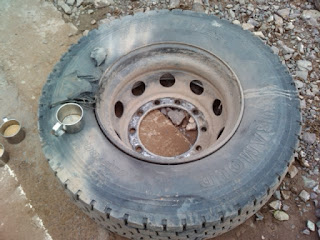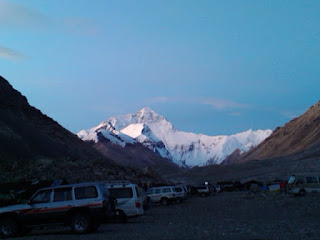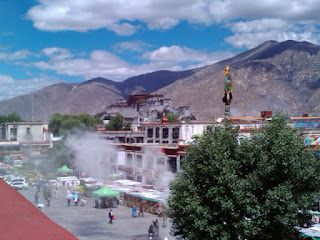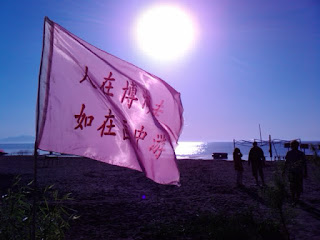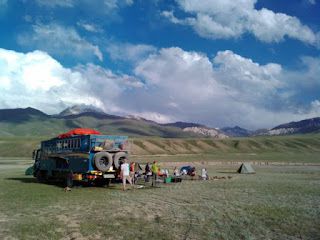Tibet has two official tourist roads: the road from Nepal in the south, and the road we used to enter it from the north. We had to travel east, to Yunnan, using an unofficial road: the main road linking the two provinces. In another country, this would mean driving along a main road, but not in China.
The road varied from poor to terrible, with a smattering of non-existent thrown in for good measure. A relatively short distance took us five days of hard driving to complete, due to the state of the road and the extremely mountainous terrain. The upside of the journey was some of the most spectacular and different scenery in Tibet, with vast forests covering the mountains. It was more reminiscent of places like Scotland and northwest America than Tibet, albeit with steeper and higher terrain.
We were supposed to camp for the whole five days, but the weather turned very wet and we were put up in two hotels for the final two days: one in Markham, and one in Deqen. One of the photos is the traffic outside the hotel in Markham, it was a very rural town. So rural that the otherwise good hotel had only three rooms with showers, and the remaining rooms didn't even have access to one. However, it was much better than camping in the pouring rain.
Deqen was slightly more civilized, but still felt quite Wild West. We ate dinner in a little local restaurant: basically one room with half of it being the kitchen and half of it with chairs and tables. Whilst eating our meals, a scrabbling sound came from the kitchen area. A plastic bag rolled into view, and a chicken poked its head out! Its legs must have been tied up because it spent the rest of the time trying vainly to escape the bag. We didn't order chicken that night.
As you will see from one of the pictures, we had a rather large tyre failure. Thankfully the truck was stopped at the roadside at the time. I put a mug on the tyre to show how large the hole is, and yes, all the steel belts are broken.
The rest of the pictures are of the varying scenery on this road to Yunnan which, incidentally, we were the first overland truck to travel. It is very unusual for foreigners to see this area!
Thursday 30 July 2009
Wednesday 22 July 2009
Eclipse
On the way back from Everest, we were able to see the solar eclipse just in passing. It was maybe 90% coverage, which meant that instead of complete darkness the light just went dim and strange. The birds nearby were very confused though! I tried to photograph it but it didn't turn out too well, even 10% sunlight is too bright for a camera.
Everest
After two nights of bushcamping we reached the road leading to Mount Everest, or Qomolangma. The first pass on the 90km road gave some of the best views of the Himalayas, with five 8000m+ peaks visible, truly stunning scenery. After a wonderful drive through some picturesque hamlets we arrived at a weird tent conglomeration, a bit like a shanty town but entirely consisting of tent "hotels" for tourists like us. The hotel names are great: Metal Yak Grand Hotel; Alex English Tea House; Hotel De California; Mt. Everest Happiness Tea House and Steel Firm Guesthouse to name just a few. All of these establishments are about 5x5m tents made of brown yak hair, which makes the names even more amusing.
From here we could go up to the proper base camp, either walking or by taking the bus conveniently available for lazy people like me. So one furious bus ride up a gravel road later, we were at Everest North Base Camp. Or to be more precise, we were at the army checkpoint guarding the camp. After some time queueing to show the guards our passports, we were informed that we were not allowed into the camp, as there was some technicality wrong with our permit. I have been knocked back from clubs before, but never from a mountain! As it turns out, we didn't really miss much as to go further than the camp required a second, extremely expensive permit. Anyway, the view from tent town was better since the clouds had lifted by the evening. The following morning was better still, with not one cloud obscuring the peak at dawn, truly amazing.
Qomolangma is a real wonder of the world. Even if you didn't know that it is the highest mountain in the world, you cannot fail to be awed by it. I had a great day here, especially since I have finally acclimatised to the altitude: 5100m in tent town!
From here we could go up to the proper base camp, either walking or by taking the bus conveniently available for lazy people like me. So one furious bus ride up a gravel road later, we were at Everest North Base Camp. Or to be more precise, we were at the army checkpoint guarding the camp. After some time queueing to show the guards our passports, we were informed that we were not allowed into the camp, as there was some technicality wrong with our permit. I have been knocked back from clubs before, but never from a mountain! As it turns out, we didn't really miss much as to go further than the camp required a second, extremely expensive permit. Anyway, the view from tent town was better since the clouds had lifted by the evening. The following morning was better still, with not one cloud obscuring the peak at dawn, truly amazing.
Qomolangma is a real wonder of the world. Even if you didn't know that it is the highest mountain in the world, you cannot fail to be awed by it. I had a great day here, especially since I have finally acclimatised to the altitude: 5100m in tent town!
Tuesday 21 July 2009
Friday 17 July 2009
Altitude and Lhasa
I can tell you now that altitude sickness is truly awful. Imagine being so exhausted that all you want to do is collapse into bed, but you cannot sleep because of the headache pounding away. Then add to this constant dry retching because you have already emptied the contents of your stomach hours ago. You then become desperately thirsty and hungry, but anything you consume reappears almost immediately. This happened to me on the night we had to drive past the roadworks, as this was the part of the journey in which we ascended to high altitude, unfortunately I suffered badly. The "road" had degenerated into a muddy track filled with holes and our truck shook from side to side constantly, this put paid to any faint notion of sleep. A further night's camp at 4700m altitude, at Namtso Lake, was better, but still not wonderful. This was a pity, because it was a stunningly beautiful place which I was not able to appreciate. Thankfully we finally descended into Lhasa, which is only at 3600m, and I have been able to acclimatise better.
Lhasa is a bittersweet experience. Again, most of the town could be anywhere in China, with wide avenues flanked by innumerable shops, cars with their horns seemingly stuck in the on position and Mandarin the language of choice. But go behind the Chinese frontage and find the old town and you see what Lhasa must have been like before it was "improved".
The people speak a totally different language, the buildings are markedly different and crowd in on the narrow lanes which are all paved in granite. The whole feel of the place is different, and definitely not Chinese. Prayer wheels are the accessory of choice, and monks are still a relatively common sight. Of course most of the important sites have been taken over by the Chinese, with mixed results.
We went to the Jokhang Temple and the Sera Monastery yesterday, and despite the heavy security presence, both visible and hidden, both these sites were fantastic to visit. The temple was still very much in use, and fascinating to see the devotees practice their faith. At the monastery we were fortunate enough to be there when the monks were debating, this is quite energetic and takes place outside under a grove of trees. It was strangely calming to sit and watch them make their arguments and responses, they are obviously used to being photographed by tourists. Apparently there used to be 6600 monks in Lhasa, now there are only 660: I can only imagine how it must have looked in its heyday.
Today we visited the Potala Palace, the main landmark in Lhasa, and probably Tibet: it towers over the city and is astonishingly beautiful to see. I was hugely disappointed by it. Why? Because of massively over bureaucratic nonsense to get in, incompetent overseers whilst inside, a train track tour of a infinitesimally small part of it whilst there and little in the way of "feel". In a very real sense, to me the Palace is a microcosm of Tibet: ruled from afar by those who could care less.
Something odd did happen to me here though, I was interviewed by Tibet TV along with one of my fellow travellers, Robin. We were sitting in a rather nice rooftop restaurant which had only just opened that day, and a TV crew arrived to film something for, I assume, the local news. They must have decided that we were too good an opportunity to pass up. I was handed a mobile phone by one of the waitresses and the man on the other end told me some random facts about the restaurant, upon which he hung up! With nothing but this cryptic message to guide me a camera and microphone were thrust into my face, and so I fumbled my way through some positive comments about the place and the town. Thankfully they seemed happy with that and moved onto Robin, who was, if anything, more bewildered than I as he had not spoken to the mystery man on the phone. We did get some free beer as a thankyou from the restaurant though, so it wasn't all bad.
Pics are the Tibetan plateau at dawn with part of the "road" visible at the bottom, and the square outside the Jokhang Temple with Potala Palace in the distance.
Lhasa is a bittersweet experience. Again, most of the town could be anywhere in China, with wide avenues flanked by innumerable shops, cars with their horns seemingly stuck in the on position and Mandarin the language of choice. But go behind the Chinese frontage and find the old town and you see what Lhasa must have been like before it was "improved".
The people speak a totally different language, the buildings are markedly different and crowd in on the narrow lanes which are all paved in granite. The whole feel of the place is different, and definitely not Chinese. Prayer wheels are the accessory of choice, and monks are still a relatively common sight. Of course most of the important sites have been taken over by the Chinese, with mixed results.
We went to the Jokhang Temple and the Sera Monastery yesterday, and despite the heavy security presence, both visible and hidden, both these sites were fantastic to visit. The temple was still very much in use, and fascinating to see the devotees practice their faith. At the monastery we were fortunate enough to be there when the monks were debating, this is quite energetic and takes place outside under a grove of trees. It was strangely calming to sit and watch them make their arguments and responses, they are obviously used to being photographed by tourists. Apparently there used to be 6600 monks in Lhasa, now there are only 660: I can only imagine how it must have looked in its heyday.
Today we visited the Potala Palace, the main landmark in Lhasa, and probably Tibet: it towers over the city and is astonishingly beautiful to see. I was hugely disappointed by it. Why? Because of massively over bureaucratic nonsense to get in, incompetent overseers whilst inside, a train track tour of a infinitesimally small part of it whilst there and little in the way of "feel". In a very real sense, to me the Palace is a microcosm of Tibet: ruled from afar by those who could care less.
Something odd did happen to me here though, I was interviewed by Tibet TV along with one of my fellow travellers, Robin. We were sitting in a rather nice rooftop restaurant which had only just opened that day, and a TV crew arrived to film something for, I assume, the local news. They must have decided that we were too good an opportunity to pass up. I was handed a mobile phone by one of the waitresses and the man on the other end told me some random facts about the restaurant, upon which he hung up! With nothing but this cryptic message to guide me a camera and microphone were thrust into my face, and so I fumbled my way through some positive comments about the place and the town. Thankfully they seemed happy with that and moved onto Robin, who was, if anything, more bewildered than I as he had not spoken to the mystery man on the phone. We did get some free beer as a thankyou from the restaurant though, so it wasn't all bad.
Pics are the Tibetan plateau at dawn with part of the "road" visible at the bottom, and the square outside the Jokhang Temple with Potala Palace in the distance.
Saturday 11 July 2009
Travel in China
After two long days of desert driving we arrived in Turpan, the second lowest place on the planet not underwater. And it was seriously hot. 43C in the shade is almost unbelievable for an Aberdonian, and makes it difficult to leave the comfort of air conditioning. We only spent one night here because of the heat, but we still visited the most important tourist spot: the Jiaohe ruins.
This is basically the remains of a whole town on an island in the middle of a river, and it is remarkably well preserved. You really get the feel of the place walking the streets and seeing the buildings, the Buddhist monastery is the best one imho. But it is easy to see why the town was abandoned, the heat even at 7pm is stifling, and combined with the various people trying to invade it at regular intervals it must have seemed like a poor choice of home.
From Turpan we headed for the relative cool of Dunhuang, a small tourist town with big tourist prices. Here as well China has been developing the town, much of the centre is brand new, with lots of shops aimed at well-heeled tourists.
Dunhuang is one of these towns which manages to be located near lots of interesting sites: top billing goes to the Mogao caves. This is one of those historic places which it is impossible not to visit as it houses some of the most impressive Buddhist art in the world. Even those of us not normally taken by "old stuff" really enjoyed it, I personally found it astonishing, particularly since it survived the Cultural Revolution unscathed. The tour guide shows you perhaps ten of the caves, with interesting stories about each one, this takes about one to one and a half hours. There are over 700 caves, this should give you an idea of the size of the place.
Those who were interested also visited the singing sand dunes. Now you would expect to just drive to the dunes, get out and have a look around, yes? Not in tourist China you don't. You drive to the roadblock 200m away, then walk to the ticket office and pay 120 yuan just to get in. Then once inside, you pay for anything and everything else: regimented camel rides, quad biking, even sand boarding costs you money. I decided to save my money for other things and started to walk back to get a taxi to the town with two others. The cheeky taxi drivers tried to charge us 50% more to get back than to take us there, so we decided to walk the 40 minutes back.
Good thing too, as soon after a local bus drove past us and tooted for us to get on, so we did. For one measly yuan per person we had a great leisurely city tour of the places tourists don't get to see, and we were dropped off right in the centre of town. I highly recommend just getting on a bus in a strange Chinese town, as you start to see just a little behind the facade of "New China" plastered over the main streets.
We have now pretty much left the Silk Road, as we are heading south towards Lhasa. We just spent a night in Golmud, a town rather unfairly described by the Lonely Planet guidebook as only fit for road engineers and escaped convicts. Ok, so it isn't the most beautiful of towns, and the view from our nice hotel window at night was of five brothels plying their trade, but it had a certain gutter charm to it.
Next stop of consequence is Lhasa, but to get there we have to drive overnight tonight, due to weird Chinese roadworks which close the road completely during the day. No fun for us, but even less fun for Tim and Cheryl who have to drive us.
Pics are flag at bushcamp at lake Bosten, view of Turpan depression from truck, and the Great Wall of China, non-tourist end.
This is basically the remains of a whole town on an island in the middle of a river, and it is remarkably well preserved. You really get the feel of the place walking the streets and seeing the buildings, the Buddhist monastery is the best one imho. But it is easy to see why the town was abandoned, the heat even at 7pm is stifling, and combined with the various people trying to invade it at regular intervals it must have seemed like a poor choice of home.
From Turpan we headed for the relative cool of Dunhuang, a small tourist town with big tourist prices. Here as well China has been developing the town, much of the centre is brand new, with lots of shops aimed at well-heeled tourists.
Dunhuang is one of these towns which manages to be located near lots of interesting sites: top billing goes to the Mogao caves. This is one of those historic places which it is impossible not to visit as it houses some of the most impressive Buddhist art in the world. Even those of us not normally taken by "old stuff" really enjoyed it, I personally found it astonishing, particularly since it survived the Cultural Revolution unscathed. The tour guide shows you perhaps ten of the caves, with interesting stories about each one, this takes about one to one and a half hours. There are over 700 caves, this should give you an idea of the size of the place.
Those who were interested also visited the singing sand dunes. Now you would expect to just drive to the dunes, get out and have a look around, yes? Not in tourist China you don't. You drive to the roadblock 200m away, then walk to the ticket office and pay 120 yuan just to get in. Then once inside, you pay for anything and everything else: regimented camel rides, quad biking, even sand boarding costs you money. I decided to save my money for other things and started to walk back to get a taxi to the town with two others. The cheeky taxi drivers tried to charge us 50% more to get back than to take us there, so we decided to walk the 40 minutes back.
Good thing too, as soon after a local bus drove past us and tooted for us to get on, so we did. For one measly yuan per person we had a great leisurely city tour of the places tourists don't get to see, and we were dropped off right in the centre of town. I highly recommend just getting on a bus in a strange Chinese town, as you start to see just a little behind the facade of "New China" plastered over the main streets.
We have now pretty much left the Silk Road, as we are heading south towards Lhasa. We just spent a night in Golmud, a town rather unfairly described by the Lonely Planet guidebook as only fit for road engineers and escaped convicts. Ok, so it isn't the most beautiful of towns, and the view from our nice hotel window at night was of five brothels plying their trade, but it had a certain gutter charm to it.
Next stop of consequence is Lhasa, but to get there we have to drive overnight tonight, due to weird Chinese roadworks which close the road completely during the day. No fun for us, but even less fun for Tim and Cheryl who have to drive us.
Pics are flag at bushcamp at lake Bosten, view of Turpan depression from truck, and the Great Wall of China, non-tourist end.
Saturday 4 July 2009
China likes me, I like China
Well, we made it into China, with no problems to speak of. The border was time consuming but I was pleasantly surprised to find the staff polite and efficient, a welcome change from some previous borders. Another welcome change is the roads: so far almost all are excellent, even skirting the Taklamakan the road is superb.
But I am getting ahead of myself here. First stop in China was Kashgar, which was pretty much totally not what I was expecting. Having visited much of Central Asia, I was thinking that Kashgar would be a repeat of the Silk Road market towns we have already visited, with a token nod to Chinese rule. How wrong I was. It is a bit like going to a mini version of Shanghai with a small Silk Road town in the middle: Beijing definitely rules here. Except for the old town, which appears to have been kept as a tourist attraction, the streets are all wide avenues, the buildings are all tall, modern and concrete, the signs are neon and the shops are endless. The main street has underpasses for pedestrians, nothing special in itself, but under the length of the road is a huge shopping centre. The new town has obviously been carefully planned to be a city fit for the modern age, the car is given equality with people.
But most people here have electric scooters to get around, which I think are great. They are cheap, around £400 new, don't need licensing and you just need a wall socket to charge it. They do all seem to come with the most annoying alarms in the world, though.
I didn't do a great deal in Kashgar, just wandering around and shopping. It is a lovely city for relaxing in, which is exactly what I wanted. Just to prove how chinese it is, here is a picture of a Hot'N'Spicy Chicken Rice burger I had at a fast food place called Dico's, it tasted much better than it looks. Also the Chinese border post, where we all had our temperature taken to see if we were too ill to be let in to the country.
But I am getting ahead of myself here. First stop in China was Kashgar, which was pretty much totally not what I was expecting. Having visited much of Central Asia, I was thinking that Kashgar would be a repeat of the Silk Road market towns we have already visited, with a token nod to Chinese rule. How wrong I was. It is a bit like going to a mini version of Shanghai with a small Silk Road town in the middle: Beijing definitely rules here. Except for the old town, which appears to have been kept as a tourist attraction, the streets are all wide avenues, the buildings are all tall, modern and concrete, the signs are neon and the shops are endless. The main street has underpasses for pedestrians, nothing special in itself, but under the length of the road is a huge shopping centre. The new town has obviously been carefully planned to be a city fit for the modern age, the car is given equality with people.
But most people here have electric scooters to get around, which I think are great. They are cheap, around £400 new, don't need licensing and you just need a wall socket to charge it. They do all seem to come with the most annoying alarms in the world, though.
I didn't do a great deal in Kashgar, just wandering around and shopping. It is a lovely city for relaxing in, which is exactly what I wanted. Just to prove how chinese it is, here is a picture of a Hot'N'Spicy Chicken Rice burger I had at a fast food place called Dico's, it tasted much better than it looks. Also the Chinese border post, where we all had our temperature taken to see if we were too ill to be let in to the country.
Wednesday 1 July 2009
China here we come
As I write this, we have two more nights before the Chinese border crossing, over the Torugart Pass. This is uncharted territory for us, and for Odyssey, since last year's trip was unable to enter China for various reasons. However, at our last bushcamp at Djety Oguz we met another overland group who had just come from China, which shows that it can be done, and done recently.
The other group were a Dragoman group travelling from India to Istanbul. Their crew traded advice with our crew, and we got a chance to meet some other overlanders in the setting of the first Odyssey Pub Quiz.
We learned quite a bit about overlanding with the "other lot", for example that they were on their second truck because the first one broke down five times. The second truck was also apparently the worse of the two, and had broken a suspension spring near Bishkek for which they were having trouble sourcing a replacement. They were also paying substantially more for six months with Dragoman than we have for six months with Odyssey.
There are some benefits to Dragoman of course, they seemed to stay in more and better hotels than us, their group size is smaller, and they have the option to travel in shorter legs if the client desires. It was clear to me, however, that a not inconsiderable number of them seemed to prefer our truck and our way of doing things. And they were really jealous of our chairs! I think that Odyssey will have some more customers next year.
Just over the hills in the background of the picture is China.
The other group were a Dragoman group travelling from India to Istanbul. Their crew traded advice with our crew, and we got a chance to meet some other overlanders in the setting of the first Odyssey Pub Quiz.
We learned quite a bit about overlanding with the "other lot", for example that they were on their second truck because the first one broke down five times. The second truck was also apparently the worse of the two, and had broken a suspension spring near Bishkek for which they were having trouble sourcing a replacement. They were also paying substantially more for six months with Dragoman than we have for six months with Odyssey.
There are some benefits to Dragoman of course, they seemed to stay in more and better hotels than us, their group size is smaller, and they have the option to travel in shorter legs if the client desires. It was clear to me, however, that a not inconsiderable number of them seemed to prefer our truck and our way of doing things. And they were really jealous of our chairs! I think that Odyssey will have some more customers next year.
Just over the hills in the background of the picture is China.
Subscribe to:
Posts (Atom)
PicMap
View Partwayround Picmap in a larger map




